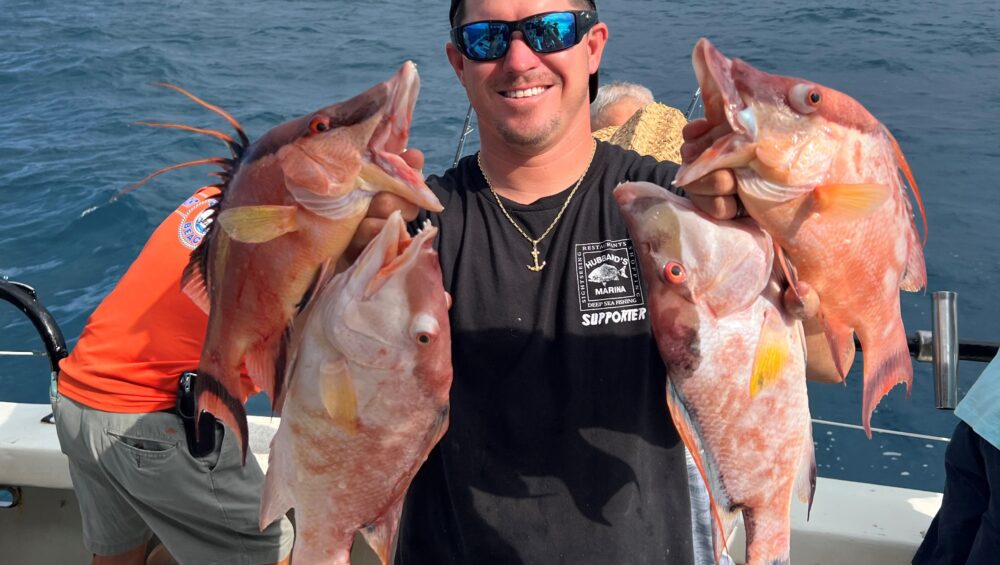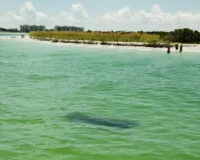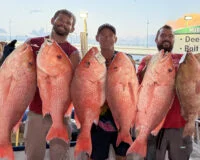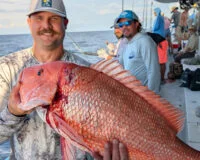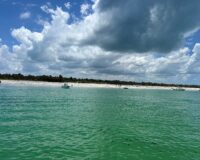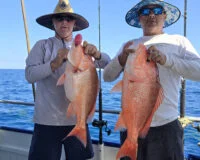Inshore Report
Snook fishing has been going well Inshore. We’re seeing those snook really active throughout the entire area. Action has been going well even on the beaches already, which is early for this time of year. However, the water warmed up quickly. We’re already seeing them around the passes heavily too. Keep in mind, that number on the beaches, and in the passes should continue to grow as the water continues to warm. Snook have been really cued into a variety of different baits from the flare hawks style Jigs to the soft plastics and everything in between. It’s been a quick change from the wintertime pattern of more of a crustacean bite to the small baits of the early spring to now finding really actively feeding snook chasing a variety of different baits in all sizes. Snook are extremely opportunistic fish. This means when targeting snook, no matter what bait you choose make sure you’re presenting that in an area where the snook can attack with a little effort. Especially if you’re fishing an area where the current is moving. Those fish are going to stack so they can ambush passing bait with a little effort. They’re very smart fish, but also very opportunistic. The old saying work smart, not hard I think was invented by a snook. They often will hang in the relief of the current, waiting for bait to get pushed to them by the current, so they have very minimal effort required to ambush passing bait. The same thing applies if you’re working an artificial lure so you always want to be conscious of where those ambush points would be, and how the current is running so you can present your bait naturally to those super smart and selective snook.
Redfish action has been going well around the area too; we’re seeing those red fish even hang out inside the passes. We’re seeing more and more fish moving around as water temperatures change. We even saw some redfish cruising into the pass, heavily around our dock lines, bridge lines, and even around the jetties. We have seen some redfish out on the beaches as well. However, most of the redfish have been hanging in the back bay waters around the grass flats, oyster bars, and mangrove shorelines. Around those areas in the back bay like the grass flats, a lot of folks, this time of year start to cast net the white bait in huge quantities enabling live chumming with green backs, which generally gets those redfish out of the mangroves feeding more actively. We’re seeing a pretty active redfish bite around the area.
Trout action has been going well throughout the area two were seeing trout from the back they waters all the way to the beaches and everywhere in between. Trout love to hang out around different areas and a variety of different habitats. We’re seeing trout on the beaches around the bridge lights and dock lights at night to the back bay water creak mouths. Trout will also bite a variety of different baits to from the artificials to the Live Bait in a variety of each. Generally, it’s a live shrimp, live green back, or soft plastic. Trout are similar to Snook in the fact that they like to gang up in areas that makes it easier for them to opportunistically feed an ambush passing bait. However, they’re not as structurally oriented as a snook.
Mackerel action is going well around our Inshore waters mostly around areas with deeper water and bait present. Look for mackerel around the passes, fishing piers, and deeper grass flats. Generally, in areas with faster moving deeper waters where bait is present you will find concentrations of mackerel actively feeding too. Mackerel love the beach fishing piers and the larger bridges of Tampa Bay. Specifically, the skyway fishing pier is a great area that holds mackerel almost year-round.
Pompano action is going well around the area too. We’re still seeing some pretty good pompano numbers around our local passes, beaches, and some of those sandy edges of local grass flats. Pompano love running those sandy edges like the troughs that run parallel to the beach with a little sandy drop offs like the roles just off the local grass flats, or the edges of the channels and cuts of the area. Pompano move and small schools and concentrations patrolling for crustaceans like crabs, shrimp or sand fleas. Pompano are generally caught using free lined, or nearly free lined live shrimp on the bottom, but you can also use sand fleas too. However, a lot of people use artificial lures like the pompano jigs with a small yellow tail teaser to target pompano around the area.
Jack crevalle are still pretty active and prolific through our inshore waters right now, or seen a lot of Jack crevalle around the flats, mangroves and oyster bars. We see them some in the pass and on the beaches, but numbers are starting to thin out a bit as we move more into the summertime pattern. However, you can still spot schools of these Jacks around, which are always fun to target and easy to catch.
nearshore Report
Mackerel action is still going extremely well near shore. We’re seeing mackerel from our beautiful beaches all the way out to around 70 to 80 foot of water. Mackerel generally are caught using trolling set ups near sure when we’re throwing out to our fishing spots in deeper water. However, you can go out there to any near shore, artificial reef or wreck between 3 and 16 miles anchor up and chum, and you will have endless mackerel action surrounding your boat and potentially even some king fish, especially as you get deeper. Generally, for mackerel, a long shank one ot hook is a great option to target the mackerel, using free lined white bait. For the king fish, generally you’re using a stinger rig with light wire and a treble hook combo. When you’re chumming fish to your boat and either drifting or flatline fishing. However, when trolling we’re seeing the mackerel and king fish on King spoons and planers. For more action on the mackerel a smaller spoon works well, while king fish like that 6 inch spoon or larger.
Hog fish action is still going decently near shore this past week. Overall, while the hog fish bite slowed down a bit we’re still seeing some decent numbers of hog fish around the area. Mostly around 30 to 70 foot of water is where we target the hog fish, but this time of year we see them more frequently a little deeper closer to that 70 foot mark. The hog fish are still looking for that light tackle and live shrimp but this time of year as water warms, they spread out they get more leader, shy, less aggressive, and less concentrated around area structures.
Lane snapper action going pretty good nearshore anywhere from about 50 to 100 foot of water. We’re finding decent numbers of lane snapper. While the lane snapper concentrations can fluctuate in areas generally were seen decent numbers of lane snapper overall. Mostly on cut squid or cut thread fins the great bait to target them lane snapper.
Mangrove snapper are mostly deeper nearshore. Once you’re beyond 60-70 foot of water up to the deepest nearshore waters, which is 100 foot. We’re seeing those mangrove snapper feeding mostly on the cut threadfin and the double snell rig but we also catch them using live shrimp too. I would generally prefer a double Snell rig with a small chunk of threadfin to target mangrove snapper. However, many like using the shrimp in a light jig head, but those shrimp can come off the hook, extremely easy, which makes it a little bit more challenging to get dialed in on the mangroves unless you can get them chummed up off the bottom, feeding more in the water column.
Red grouper action nearshore has been a little tricky. We’re seeing more of the red grouper in deeper offshore waters. But if you make it to the deeper nearshore waters, closer to 100 foot, you have a much better chance at finding some keeper red grouper near shore. We’re still seeing a lot of under size red grouper mixed in, which means you have to do a lot of catching and releasing if you’re targeting red grouper near shore in shallow waters, so make sure you’re prepared with the proper tools and techniques to ensure the proper release and safe handling of these under size fish that will be next year And the year after’s keeper fish.
offshore Report
Big red grouper have been biting well for us offshore we’re fishing closer to 140 foot of water or more right now on our offshore fishing trips and generally doing really well on some big fat red grouper. We’re also finding some decent scamp grouper in this depth range too. The scamp Grouper are always a welcome addition while targeting those red grouper in deeper water. Scamp grouper generally feed on small Pinfish for threadfins for the most part while red grouper will bite those baits plus squid, and just about anything else. Red grouper much less picky compared to a scamp grouper. and generally red grouper are more plentiful as well. However, a scamp Grouper is a great eating fish. They just generally are a little smaller than the red grouper.
We’re also seeing some pretty good numbers of mangrove snapper offshore to mangrove snapper offshore definitely are better targeted with a cut threadfin and double Snell rig. Once you get into deeper water beyond 100 to 120‘ of water using a shrimp becomes more and more unrealistic. As the deeper depth makes sensitivity to your hook extremely more difficult. The deeper the water, the harder it is to feel that soft bite that will steal your shrimp. Shrimp come off the hook extremely easy which means it’s very easy to lose your bite without feeling it offshore. That’s why we prefer the double snell rig especially in deeper water. It’s going to give you a much better chance to get those mangrove snapper with better efficiency.
We’re also seeing some mutton snapper while offshore right now! The mutton snapper bite is generally sporadic and rarer for us and central west Florida but lately we’ve been seen some decent numbers of mutton snapper. Generally, we catch them while targeting the mangrove snapper and using that Double Snell rig with cut threadfin. We’re also seeing big numbers of large vermilion snapper and the deeper we go, the vermilion snapper get even more prolific plus they seem to be in larger sizes. Along with the vermilion snapper, we see the same phenomenon with Porgy’s as we get deeper they get larger and more prolific. Another random species that we’re seeing offshore heavily right now are the African pompano. African pompano vary in concentrations but this time of year we seem to be seeing quite a few African pompano. Generally we find them beyond 120 to 140 foot but that that range and deeper seems to be the hotspot.
Offshore, pelagic action has been going really well too. We’ve been seeing decent numbers of blackfin tuna while trolling or flatline fishing. Kingfish action has been going really well offshore and deeper water as well. Trolling between spots with the Rapala Xrap or the nomad DTX has been a great option. We’re also finding these pelagic species on the flat lines with either a dead threadfin, or will use a sabiki rig to sabiki up some live sardines or a live threadfins. But many people will make the mistake of waiting till they have the perfect flatline bait to set out a flat line, but remember some truly large trophy fish are caught using dead bait on the flat line.

